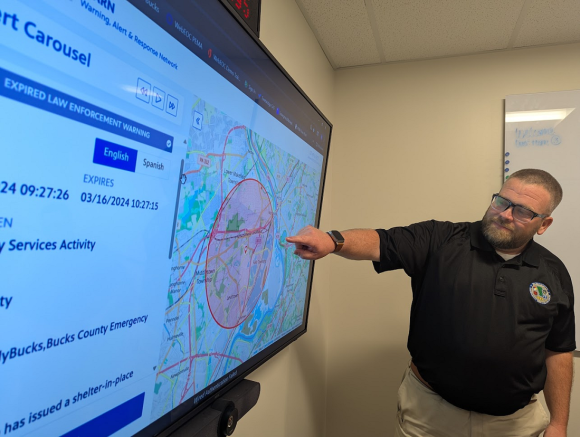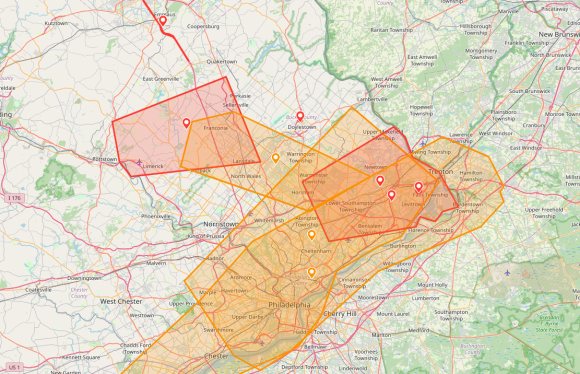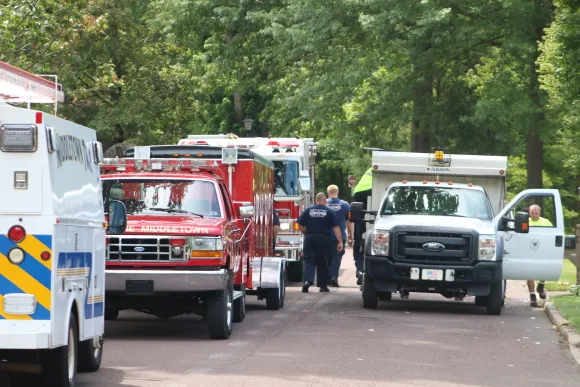From police standoffs to severe weather, many Bucks County residents have heard the distinct, loud alarm of an emergency alert on their cell phones. But as many wonder how these urgent messages work and why they sometimes may feel random, the county’s emergency management director is pulling back the curtain on how the systems work.
Bucks County uses a variety of systems to alert residents during emergencies, including a “reverse 9-1-1” platform and modern Wireless Emergency Alerts (WEA) that produce the distinctive alarm sound on cell phones.
George Wilson, the county’s director of emergency management, recently explained the systems from the Emergency Operations Center in Ivyland Borough.
The county’s traditional “reverse 9-1-1” system, now called “Resident Connect,” sends phone calls and text messages to numbers registered to specific addresses.

“That technology basically used to just take all the data that we would put into our 9-1-1 center. Where we could grab that data and send that stuff back to those numbers that we already had,” Wilson said.
The system faces challenges as fewer residents use landlines, and cell phone numbers are often tied to home addresses, not a person’s current location.
“We don’t have many people with hardline phones anymore,” Wilson said. “Now, everybody’s dependent on these cell phones or they’re using voice over IP through their internet provider.”
For cell phone users, the county also utilizes Wireless Emergency Alerts (WEA), which are distributed through the federal Integrated Public Alert Warning System (IPAWS). These alerts use a phone’s GPS data to target specific areas and are reserved for situations that need immediate public action.
“If the emergency management staff here in cooperation with the 9-1-1 center are sending a WEA, it’s because we want the public to do something,” Wilson said. “We’re not sending it for awareness. We need and want you to do something.”
Wilson estimated the county sends fewer than 50 alert messages per year across all systems to avoid message fatigue.

“I’m very conservative about doing a message because I want to make sure that we’re sending messages for action, not just awareness,” he said.
The choice of alert system depends on the nature of the emergency, Wilson explained.
Resident Connect is typically used for “fixed” threats, like a police operation in a specific neighborhood.
WEA is used for mobile threats or incidents that require a broader public response, like hazardous material spills or flooding.
“I look at those messages for typically for threats or hazards that are fixed,” Wilson said of Resident Connect.

Local responders can request an alert by contacting the 9-1-1 center, but the final decision on the message type and coverage area is made by emergency management officials.
“We typically allow the local responders or emergency management coordinators that are on the ground to make the decisions. They call up and request, ‘hey, I need this kind of messaging for this area,'” Wilson said. “And then typically the emergency management staff, either myself when I’m here or my designee if I’m away, makes the determination of both area and messaging.”
The alert systems do have limitations.
“When we do that messaging, we have to build two separate messages,” Wilson said. “We have to build a 90 character message, which is extremely difficult if you ever tried. And then you have to build a 360 character message that is usually typically more detailed.”
Wilson stressed the importance of residents keeping emergency alerts enabled on their phones.
James O’Malley, the county’s deputy communication’s director and who frequently works with emergency officials, said residents don’t know when an emergency may occur, but it’s important emergency alerts can come through.
The only alert that cannot be disabled is a presidential alert, while users can turn off Amber Alerts and local emergency notifications.
“The presidential alert overrides everything. There’s no turn off switch for that,” Wilson said.
The county manages the voluntary Ready Bucks notification system, which sends community and non-emergency information, such as snow emergency declarations.
Wilson recommends residents follow county emergency services and local municipalities on social media to stay aware during emergencies.
Alerts from the county can also be sent through the Emergency Alert System on television and radio, and via NOAA weather radios.
Despite some limitations on the system, Wilson said Bucks County uses the best available technology for emergency notifications.
“It’s not a perfect system, but it’s the best we have that works,” he said.